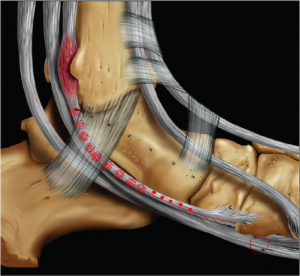These pages offer advice only. They are not a substitute for a proper consultation.
The Midfoot
This is where the metatarsal bones are joined onto the rest of the hindfoot at the 'tarso-metatarsal joints'. These are usually fairly stiff joints, but also carry a large load. They form the apex of the arch of the foot, with the ends of the arch tied together with the plantar fascia. This is stretched between the bottom of the heel bone and the bases of the toes.
Location of the Plantar Fascia
The plantar fascia can be felt under the foot by pulling up on your big toe and feeling under the arch, which increases in size. This is known as the 'Windlass' mechanism and is very important in saving enrgy as we walk.
There are other ligaments located deeper than the plantar fascia. These include the spring ligaments, the failure of which will lead to a flat foot. The commonest cause of this (in middle age) is when it is associated with Tibialis Posterior Tendon failure as described in 'The Subtalar Joint' [is it?]. Early diagnosis of this condition is essential if major surgery is to be avoided.

Another condition commonly effecting the midfoot is osteoarthritis. Symptoms of this include inflammation, bony swelling, and pain. The bump that forms on the top of the foot can rub against the shoe, causing more pain.
These joints are occasionally injured when a severe twisting force breaks the second metatarsal and dislocates the midfoot, which then springs back (Lisfranc injury). In these cases, X-rays only show subtle changes which are often missed. Any severe twisting motion to the foot leading to an inabiliy to walk accompanied by marked swelling in the area needs careful interpretation of X-rays. Missed injuries can commonly lead to osteoarthritis.